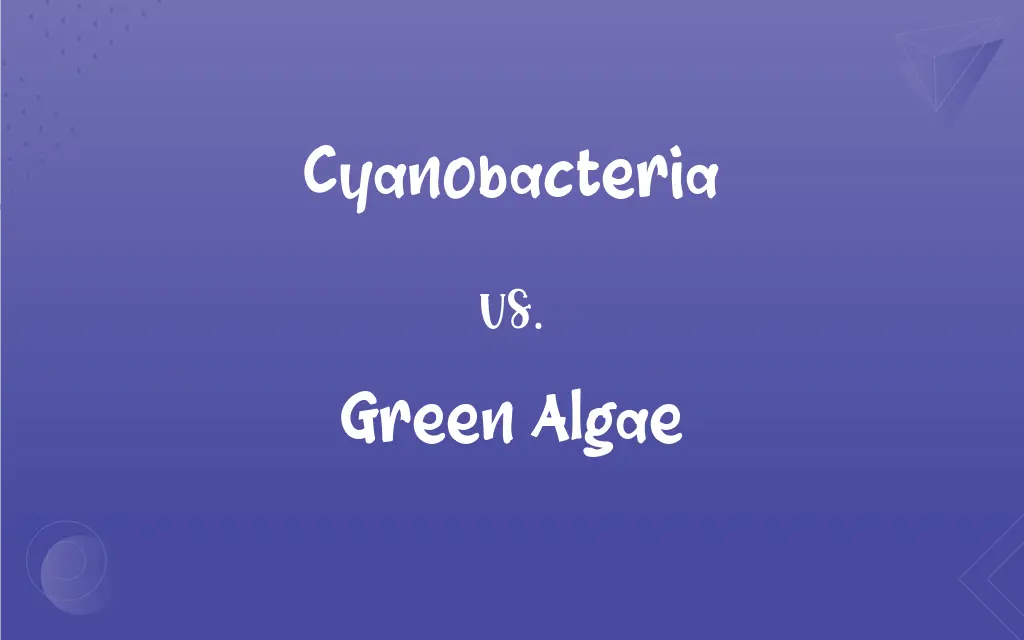Cyanobacteria vs. Green Algae: What's the Difference?
Edited by Janet White || By Harlon Moss || Updated on October 27, 2023
Cyanobacteria are prokaryotic, photosynthetic bacteria; green algae are eukaryotic, photosynthetic organisms.

Key Differences
Cyanobacteria, often known as blue-green algae, are prokaryotic organisms, meaning they lack a nucleus. Green algae, in contrast, are eukaryotic and possess a defined nucleus.
Cyanobacteria thrive in diverse environments, including extreme conditions. Green algae primarily inhabit freshwater and marine environments, showing less extremophilic tendencies.
Cyanobacteria perform photosynthesis, possessing chlorophyll-a and phycobilins. Green algae also conduct photosynthesis and contain chlorophyll-a and -b, giving them their characteristic color.
Cyanobacteria play a crucial role in nitrogen fixation. Green algae contribute significantly to aquatic ecosystems, forming the base of many food chains.
Cyanobacteria reproduce primarily through binary fission. Green algae display a more diverse range of reproductive strategies, including both asexual and sexual reproduction.
ADVERTISEMENT
Comparison Chart
Cell Type
Prokaryotic (no nucleus)
Eukaryotic (with nucleus)
Habitat
Diverse, including extreme
Mainly freshwater and marine
Photosynthetic Pigments
Chlorophyll-a, phycobilins
Chlorophyll-a, chlorophyll-b
Ecological Role
Nitrogen fixation
Base of aquatic food chains
Cyanobacteria and Green Algae Definitions
Cyanobacteria
Cyanobacteria are also known as blue-green algae.
The blue-green color of cyanobacteria is distinctive.
ADVERTISEMENT
Green Algae
Green algae are eukaryotic, photosynthetic organisms.
Green algae are an essential part of freshwater ecosystems.
Cyanobacteria
Cyanobacteria can survive in extreme environments.
Cyanobacteria are found even in hot springs.
Green Algae
Green algae inhabit mainly freshwater and marine environments.
Ponds and lakes are common habitats for green algae.
Cyanobacteria
Cyanobacteria are photosynthetic, prokaryotic organisms.
Cyanobacteria play a vital role in marine ecosystems.
Green Algae
Green algae possess chlorophyll-a and -b.
The green color of these algae comes from chlorophyll pigments.
Cyanobacteria
Cyanobacteria contribute to nitrogen fixation.
Cyanobacteria enrich soil by fixing atmospheric nitrogen.
Green Algae
Green algae are important in aquatic food chains.
Many aquatic creatures feed on green algae.
Cyanobacteria
Cyanobacteria reproduce mainly through binary fission.
Cyanobacteria populations can grow rapidly through binary fission.
Cyanobacteria
Any of various photosynthetic bacteria of the phylum Cyanobacteria that are generally blue-green in color and are widespread in marine and freshwater environments, with some species capable of nitrogen fixation. Also called blue-green alga, blue-green bacterium.
Cyanobacteria
Plural of cyanobacterium.
Cyanobacteria
Predominantly photosynthetic prokaryotic organisms containing a blue pigment in addition to chlorophyll; occur singly or in colonies in diverse habitats; important as phytoplankton
FAQs
Where do cyanobacteria commonly live?
They thrive in diverse habitats, including extreme conditions.
Do cyanobacteria have a role in nitrogen fixation?
Yes, they play a crucial role in fixing atmospheric nitrogen.
How do cyanobacteria differ from green algae?
Cyanobacteria are prokaryotic; green algae are eukaryotic.
What is the typical habitat of green algae?
Green algae mainly inhabit freshwater and marine ecosystems.
Are cyanobacteria considered true algae?
No, despite the name "blue-green algae," they are bacteria.
Can both cyanobacteria and green algae conduct photosynthesis?
Yes, both are capable of photosynthesis.
Do green algae have a nucleus?
Yes, as eukaryotes, they have a defined nucleus.
Are there any health benefits associated with green algae?
Some green algae are rich in nutrients and used in dietary supplements.
What are green algae?
Green algae are eukaryotic, photosynthetic organisms.
Is it safe to consume water with cyanobacteria blooms?
No, cyanobacteria blooms can release toxins harmful to humans and animals.
Are cyanobacteria used in any industrial applications?
Yes, they are used in biotechnology and biofuel production.
Can green algae be used as a food source?
Yes, certain types of green algae are edible and nutritious.
Do cyanobacteria blooms pose environmental risks?
Yes, blooms can deplete oxygen in water and release toxins.
What are cyanobacteria?
Cyanobacteria are prokaryotic, photosynthetic bacteria.
What pigments do cyanobacteria contain?
They contain chlorophyll-a and phycobilins.
Can both cyanobacteria and green algae exist in symbiotic relationships?
Yes, both can form symbiotic relationships with other organisms.
What pigments give green algae their color?
Chlorophyll-a and chlorophyll-b give them a green hue.
How do cyanobacteria reproduce?
They primarily reproduce through binary fission.
Are cyanobacteria found in freshwater environments?
Yes, but they also inhabit marine and extreme environments.
About Author
Written by
Harlon MossHarlon is a seasoned quality moderator and accomplished content writer for Difference Wiki. An alumnus of the prestigious University of California, he earned his degree in Computer Science. Leveraging his academic background, Harlon brings a meticulous and informed perspective to his work, ensuring content accuracy and excellence.
Edited by
Janet WhiteJanet White has been an esteemed writer and blogger for Difference Wiki. Holding a Master's degree in Science and Medical Journalism from the prestigious Boston University, she has consistently demonstrated her expertise and passion for her field. When she's not immersed in her work, Janet relishes her time exercising, delving into a good book, and cherishing moments with friends and family.































































